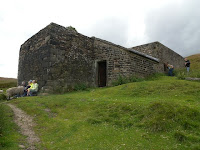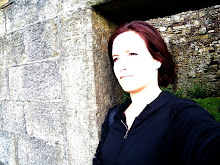I have been in Haworth for the last week or so. It is a little village on the outskirts of Keighley (pronounced key-thlee) in West Yorkshire. It is on my itinerary because of 3 very well known sisters who lived here in the mid 1800's: Anne, Emily, and Charlotte Bronte. My main interest in the Brontes is Charlotte as her novel, Jane Eyre, is one of my all time favorites. Unfortunately, most of the places Charlotte used as a basis for her settings in Jane Eyre are in and around the village of Hathersage which is situated a little too far away for me to get to using public transportation. So I have spent most of the week relaxing in the nostalgic little village center with its steep, narrow, cobblestone main street lined with old stone buildings and shops.
Better yet, I have enjoyed hiking several nearby moorland paths. The first long hike I took was a 6½ mile trek from the village center onto the Haworth Moor leading to the Bronte Bridge and Waterfall (so named because they were both places that, it is said, the Brontes knew well and spent much time enjoying). A mile or two past (and all uphill I might add) is Top Withens, a place that is claimed to be Emily's inspiration for Heathcliff's dwelling in Wuthering Heights.

The dark and stormy moors.

The Bronte Bridge.

Good thing i wore sweatshirt. The weather changes every few minutes on the moors!

Bronte Waterfall. It's really just a trickle right now. I guess it's more impressive after the winter thaw.

I was surprised when I hiked up closer to the falls to see this little sheep munching grass.

One of the many ways to get through (or over) a fence.

Top Withens from a distance.

A little closer up.
Yesterday I did a slightly shorter hike on Stanbury Moor to Penistone Crag, a large flat topped rock jutting out from the top of the moor, which is also said to have been a favorite haunt of the Bronte sisters as well as the meeting place of Cathy and Heathcliff in Wuthering Heights. I liked this hike even more than the one to Top Withens. Evidently, not as many tourists know about this so I only saw two other hikers in the 4 or 5 hours I was there. It was a beautiful day with sunshine and a light breeze so I sat on Penistone Crag and did some reading surrounded by the gorgeous scenery and bleating of sheep.

View from the top of one side of the moor to the other.

Another little waterfall.

Pools of water from the trickling spring.

Penistone Crag--you can't really tell from this pic but that's a long way down!

A nice resting spot.

A lonely crooked tree.


Fences and more fences. These are called drystone fences because they don't have mortar between the stones. That way the wind can blow through the cracks and not knock them down over time.

Penistone Crag from the other side of the moor.

Cows! innocent enough but a little scary when you're in an open field with them. At least I think so...
The Bronte Parsonage, which was home to the family, is now a museum devoted to the Bronte family. Their story is actually quite sad. The mother, Maria Branwell Bronte, died at age 38 when the children were still very young. Of the 6 children, only 4 survived into adulthood (Maria and Elizabeth died of consumption (tb) as a result of poor living conditions and harsh treatment at Cowen Bridge School. Charlotte used Cowen Bridge as the model for "Lowood" in Jane Eyre.) Charlotte lived the longest of all her sibling, dying in 1855 at age 38. Their father, Patrick Bronte, outlived all of his children.

Street view of the church.

Back view of the church. Opposite the parsonage.

The Bronte Parsonage Museum (I don't know who those people are in front, although it does look like they are posing for me).

The graveyard.

Black cat in the graveyard. How fitting.



























